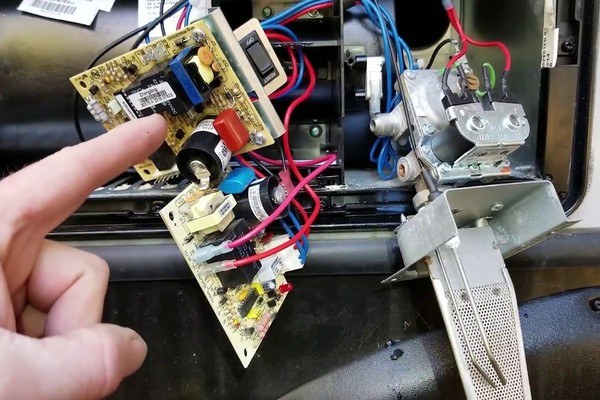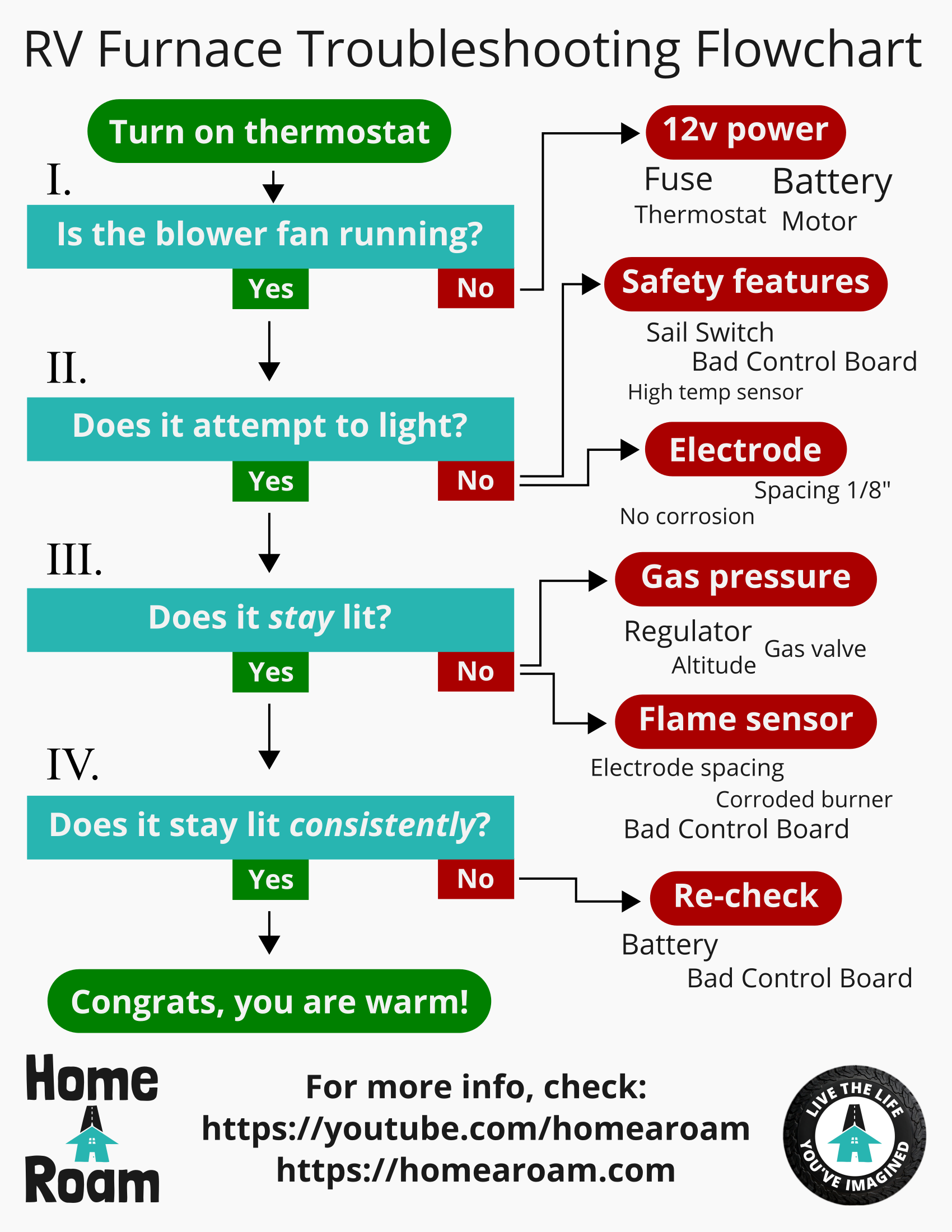RV trips can be the adventure of a lifetime. But a malfunctioning furnace can quickly spoil the fun.
Understanding how to troubleshoot your Dometic RV furnace is key to staying warm and cozy on the road. Many RV owners face furnace issues, and knowing some basics can save you time and stress. Whether it’s a simple fix or something more complex, this guide will help you identify and solve common problems.
Stay prepared and keep your RV furnace running smoothly for a comfortable journey. Let’s dive into some practical tips and insights to ensure your RV adventures remain warm and enjoyable.

Credit: www.youtube.com
Common Furnace Issues
Experiencing problems with your Dometic RV furnace can be frustrating. Understanding common issues helps in effective troubleshooting. Here are some typical problems and how to address them.
No Heat Production
If your furnace isn’t producing any heat, it could be due to several reasons. The most common causes include:
- Thermostat Issues: Ensure the thermostat is set to “heat” and at a higher temperature than the current room temperature.
- Power Supply Problems: Check if the furnace is getting power. Inspect the circuit breaker and fuses.
- Ignition System Malfunction: The pilot light or electronic ignition might be faulty. Clean or replace as needed.
- Gas Supply: Ensure the propane tank is full and the gas valve is open.
Intermittent Heating
Intermittent heating can make your RV uncomfortable. This issue often stems from:
- Dirty Air Filters: Clogged filters restrict airflow. Clean or replace them regularly.
- Thermostat Calibration: The thermostat may not be reading the temperature correctly. Recalibrate or replace it.
- Loose Connections: Inspect wiring and connections for any signs of looseness or damage.
- Fan Motor Issues: The fan motor might be overheating. Check for obstructions and ensure it is lubricated.
By understanding these common issues, you can troubleshoot your Dometic RV furnace more effectively. Regular maintenance can prevent many of these problems.
Safety Precautions
When troubleshooting your Dometic RV furnace, safety is crucial. You want to avoid accidents and ensure your furnace works correctly. Below are key safety precautions to consider.
Gas Leak Detection
A gas leak is dangerous. Always check for leaks before working on your furnace. Here are some steps:
- Turn off the gas supply.
- Use a gas leak detector spray on all connections.
- Look for bubbles that indicate a leak.
- If you find a leak, do not attempt to fix it yourself. Call a professional.
Proper Ventilation
Proper ventilation is vital for your safety. Poor ventilation can cause carbon monoxide buildup. Follow these steps:
- Ensure all vents are open and not blocked.
- Regularly clean vents and filters.
- Install a carbon monoxide detector in your RV.
- Check the exhaust system for any blockages.
Proper ventilation ensures your furnace runs efficiently. It also keeps you safe from harmful gases.
Tools Needed
When troubleshooting your Dometic RV furnace, having the right tools is crucial. These tools will help you diagnose and fix common issues effectively. Here, we will discuss the basic tool kit and specialized equipment needed for the job.
Basic Tool Kit
A basic tool kit is essential for any troubleshooting task. Make sure you have a set of screwdrivers. Both flathead and Phillips types are necessary. A multimeter is also important. It helps you check electrical connections. Pliers and wrenches are needed too. They help in loosening and tightening bolts and nuts. Lastly, don’t forget a flashlight. Proper lighting is key for spotting issues in dark areas.
Specialized Equipment
Sometimes, basic tools are not enough. You might need specialized equipment. A manometer is one such tool. It measures gas pressure in the furnace. Proper gas pressure ensures efficient operation. An infrared thermometer is another useful tool. It helps you check the temperature of different furnace components. This can identify overheating parts. A combustion analyzer is also handy. It measures the efficiency of the furnace. It checks the levels of gases like carbon monoxide. Ensuring safe operation is vital.

Credit: www.alhudapk.com
Initial Checks
Experiencing issues with your Dometic RV furnace? Start with some initial checks. These quick steps can help identify common problems. Follow the guidelines below for a smooth troubleshooting process.
Power Supply
First, verify the power supply to your Dometic RV furnace. Ensure the battery is charged. Check for any tripped circuit breakers. Use a multimeter to measure voltage at the furnace. It should read 12 volts DC.
Inspect the furnace’s power switch. Make sure it is in the ON position. If your RV is plugged into a power source, ensure the shore power is working. Confirm the power converter is functioning properly.
Thermostat Settings
Next, examine the thermostat settings. Set the mode to HEAT. Adjust the temperature setting above the current room temperature. This activates the furnace.
Check for loose or damaged wires connecting the thermostat to the furnace. If necessary, refer to your RV’s manual for specific wiring instructions. Ensure the thermostat has power. Replace batteries if it is battery-operated.
Inspecting Components
Inspecting components is vital for troubleshooting your Dometic RV furnace. Each part plays a key role. Understanding how these parts work helps identify issues early. This ensures your furnace operates efficiently. Let’s dive into some key components to inspect.
Burner Assembly
The burner assembly is crucial for heating. Start by checking the burner for dirt or debris. A clogged burner affects performance. Clean it thoroughly using a brush. Ensure the burner ports are free of obstructions. Next, examine the burner flame. It should be steady and blue. A yellow or flickering flame indicates issues. Adjust the air shutter to achieve a proper flame. This component needs regular inspection for optimal performance.
Ignition System
The ignition system lights the burner. First, inspect the electrode and wiring. Ensure connections are tight and corrosion-free. A dirty electrode can cause ignition failure. Clean it gently using fine-grit sandpaper. Test the spark by turning on the furnace. Observe if the electrode produces a strong spark. If not, you may need to replace it. Also, check the control board for any error codes. Understanding these codes helps diagnose ignition problems.
Cleaning Procedures
Keeping your Dometic RV furnace clean is essential for its optimal performance. Regular cleaning helps prevent malfunctions and extends the life of your furnace. This section will guide you through the cleaning procedures, focusing on filter replacement and vent cleaning.
Filter Replacement
Replacing the filter is a simple yet crucial step. A dirty filter can block airflow and reduce efficiency. Follow these steps to replace your filter:
- Turn off the furnace and disconnect the power supply.
- Locate the filter compartment, usually near the bottom.
- Remove the old filter carefully.
- Insert the new filter, ensuring it fits snugly.
- Reconnect the power and turn on the furnace.
Check the filter every month. Replace it if it looks dirty or clogged.
Vent Cleaning
Blocked vents can cause uneven heating and strain on your furnace. Clean the vents regularly to maintain proper airflow. Here’s how:
- Turn off the furnace and disconnect the power.
- Remove the vent covers using a screwdriver.
- Use a vacuum with a brush attachment to clean inside the vents.
- Inspect the vents for any blockages or debris.
- Replace the vent covers and reconnect the power.
For a deeper clean, consider using a vent cleaning brush. This tool can reach further inside the vents and remove more dust and debris.
By following these cleaning procedures, you can ensure your Dometic RV furnace runs smoothly and efficiently. Regular maintenance is key to a comfortable and warm RV experience.
Advanced Troubleshooting
Advanced troubleshooting of your Dometic RV furnace can save time and money. Many common issues are related to electrical or gas supply problems. Understanding these areas can help you diagnose and fix issues efficiently.
Electrical Issues
Electrical problems are common in Dometic RV furnaces. Start by checking the fuse or circuit breaker. A blown fuse or tripped breaker can stop the furnace from working.
- Ensure the fuse is intact.
- Check if the circuit breaker is in the correct position.
- Inspect all wires for loose connections or damage.
If the fuse and breaker are fine, check the thermostat. Ensure it is set to ‘heat’ and the temperature is set correctly. Use a multimeter to check for power at the thermostat.
Also, inspect the blower motor. A faulty motor can prevent the furnace from starting. Listen for unusual noises or vibrations.
Gas Supply Problems
Gas supply issues can also cause your furnace to malfunction. Start by checking the propane tank. Ensure it has enough fuel.
- Verify the propane valve is open.
- Inspect the regulator for proper functioning.
- Check the gas lines for leaks or blockages.
If the gas supply is fine, check the igniter. A faulty igniter can prevent the furnace from lighting. Clean the igniter and check its connections.
Finally, inspect the burner. A dirty burner can cause ignition problems. Clean it and ensure it is free from debris.
Troubleshooting these areas can help you fix most furnace problems. If issues persist, seek professional help.

Credit: homearoam.com
When To Call A Professional
Understanding when to call a professional for your Dometic RV furnace can save you time, money, and stress. Some problems might seem simple but require expert knowledge to fix. Here are some scenarios where professional help is essential.
Complex Repairs
Some issues with your RV furnace are beyond basic troubleshooting. If the furnace does not ignite or the blower motor fails, these are complex issues. Attempting these repairs without proper knowledge can damage the furnace further.
A professional will have the right tools and experience. They can diagnose the problem accurately and fix it efficiently. This ensures your furnace runs smoothly and safely.
Safety Concerns
Safety is a top priority with any furnace. Issues like gas leaks or electrical problems pose serious risks. If you smell gas or notice frayed wires, do not attempt a DIY fix.
A certified technician understands the safety protocols. They can handle these hazardous situations properly. This keeps you and your RV safe from potential accidents or fires.
Remember, dealing with furnaces involves handling flammable materials and high voltage. It is always better to be safe and call a professional. This ensures your RV furnace operates safely.
Frequently Asked Questions
How Do I Reset My Dometic Rv Furnace?
To reset, turn off the furnace. Wait five minutes. Turn it back on.
Why Is My Dometic Rv Furnace Not Igniting?
Check the propane supply. Ensure the battery is charged. Inspect the thermostat settings.
What Should I Do If My Rv Furnace Blows Cold Air?
Check the propane levels. Ensure the vents are clear. Verify the thermostat settings.
Why Does My Dometic Furnace Keep Shutting Off?
The furnace could be overheating. Check for blocked vents. Ensure proper airflow.
How Often Should I Maintain My Rv Furnace?
Service the furnace annually. Clean filters regularly. Inspect for any blockages or damage.
Conclusion
Troubleshooting your Dometic RV furnace can be straightforward with these tips. Understanding common issues helps you fix problems quickly. Regular maintenance keeps your furnace running smoothly. Always check the manual for specific guidance. Don’t hesitate to call a professional if needed.
Your RV adventures should be warm and comfortable. Happy travels and stay cozy!
